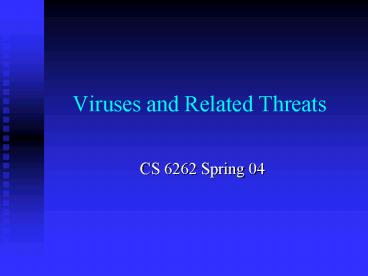Viruses and Related Threats - PowerPoint PPT Presentation
1 / 20
Title:
Viruses and Related Threats
Description:
of scans a site received at time t Overall scans in Internet at t. ... Count # of Code Red scan packets and source IPs for each hour. ... – PowerPoint PPT presentation
Number of Views:43
Avg rating:3.0/5.0
Title: Viruses and Related Threats
1
Viruses and Related Threats
- CS 6262 Spring 04
2
Malicious Programs
- Needs host program
- trap doors
- logic bombs
- Trojan horses
- viruses
- Independent
- viruses
- worms
3
Trap Doors
- A secret entry point to a program or system
- get in without the usual security access
procedures - Recognize some special sequence of inputs, or
special user ID
4
Logic Bomb
- Embedded in some legitimate program
- Explode when certain conditions are met
5
Trojan Horses
- Hidden in an apparently useful host program
- Perform some unwanted/harmful function when the
host program is executed
6
Worms and Bacteria
- Worms
- Use network connections to spread from system to
system - Bacteria
- No explicitly damage, just replicate
7
Viruses
- Infect a program by modifying it
- Self-copied into the program to spread
- Four stages
- dormant phase
- propagation phase
- E.g., attachment to email
- triggering phase
- execution phase
8
Virus Structure
- First line got to main of virus program
- Second line a special mark (infected or not)
- Main
- find uninfected programs
- infect and mark them
- do something damaging to the system
- now go to the first line of the original
program - appear to do the normal work
- Avoid detection by looking at size of program
- compress/decompress the original program
9
Types of Viruses
- Parasitic virus
- search and infect executable files
- Memory-resident virus
- infect running programs
- Boot sector virus
- spreads whenever the system is booted
- Stealth virus
- Polymorphic virus
- encrypt part of the virus program using randomly
generated key
10
Macro Viruses
- Macro
- an executable program (e.g., opening a file,
starting an application) embedded in a word
processing document, e.g. MS Word - Common technique for spreading
- A virus macro is attached to a Word document
- Document is loaded and opened in the local system
- When the macro executes, it copies itself to the
global macro file - The global macro can be activated/spread when new
documents are opened.
11
Truth and Misconceptions about Viruses
- Can only infect Microsoft Windows
- Can modify hidden and read-only files
- Spread only on disks or in email
- Cannot remain in memory after reboot
- Cannot infect hardware
- Can be malevolent, benign, or benevolent
12
Antivirus Approach
- Prevention
- Limit contact to outside world
- Detection and identification
- Removal
- 4 generations of antivirus software
- simple scanners
- use signatures of known viruses
- heuristic scanners
- integrity checking checksum, encrypted hash
- activity traps
- full-featured protection
13
Digital Immune System
- Each PC is equipped with a monitoring program
- Suspicious program is forwarded into an
administrative PC of the LAN - Administrative PC securely transmit the sample to
central virus analysis site - for emulation, analysis, prescription
- The prescription is sent back to the
administrative PC, then all PCs in the LAN - to other LANs as well
14
The Internet Worm
- What it did
- Determine where it could spread
- Spread its infection
- Remain undiscovered and undiscoverable
- Effect
- Resource exhaustion repeated infection due to a
programming bug - Servers are disconnected from the Internet by sys
admin to stop infection
15
The Internet Worm
- How it worked
- Where to spread
- Exploit security flaws
- Guess password (encrypted passwd file readable)
- fingerd buffer overflow
- sendmail trapdoor (accepts shell commands)
- Spread
- Bootstrap loader to target machine, then fetch
rest of code (password authenticated) - Remain undiscoverable
- Load code in memory, encrypt, remove file
- Periodically changed name and process ID
16
The Internet Worm
- What we learned
- Security scanning and patching
- Computer Emergency Response Team (CERT)
17
Code Red and Beyond
- http//www.icir.org/vern/talks/vp-0wn-UCB.pdf
18
Code Red Worm Background
- Sent HTTP Get request to buffer overflow Win IIS
server. - It generated 100 threads to scan simultaneously
- One reason for its fast spreading.
- Huge scan traffic might have caused congestion.
- Characteristics
- Uniformly picked IP addresses to send scan
packets. - Code Red worm incident of July 19th, 2001
- Showed how fast a worm can spread.
- more than 350,000 infected in less than one day.
19
Observing/Monitoring Code Red
- Network monitor
- record Code Red scan traffic into the local
network. - Code Red worm uniformly picked IP to scan.
- of scans a site received ? Size of the IP space
of the site. - of scans a site received at time t ? Overall
scans in Internet at t. - of infectious hosts sent scans to a site at
time t ? Overall infectious hosts in Internet at
t.
- Local observation preserves global worm
propagation pattern.
20
Observed Data on Code Red Worm
- Two independent Class B networks x.x.0.0/16
(1/65536 of IP space) - Count of Code Red scan packets and source IPs
for each hour. - Uniformly scan IP ? Two networks, same results.































